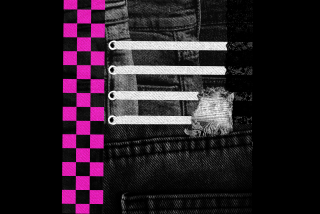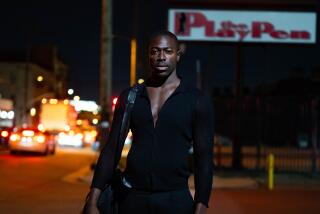From wardrobe staple to symbol of urban terror
Football coaches wear them on the sidelines. Toddlers sport them on trips to the park. They are what we grab when we run to the market or head out in the cold to walk the dogs.
Yet somehow the humble hooded sweat shirt has evolved from basic, everyday apparel to a sinister symbol of urban terror.
It has become a touchstone in the conversation about the death of Trayvon Martin, the Florida teenager who was wearing a hoodie when he was fingered as “suspicious” and shot by a Neighborhood Watch patroller.
Fox News commentator Geraldo Rivera considers the hoodie “as much responsible for Trayvon Martin’s death as George Zimmerman,” the man who shot him.
“I believe Trayvon Martin would be alive today, but for his hoodie,” Rivera said last week. “If he didn’t have that hoodie on, that nutty Neighborhood Watch guy wouldn’t have responded in that violent and aggressive way....
“Pedestrians cross the street to avoid black or brown hoodie wearers,” he said. “When you see that kid coming your way, you are thinking ghetto or ghetto wannabe.”
Rivera has been roundly mocked since he made those comments last week — including in countless Facebook posts of a brown-skinned Rivera wearing a hoodie in the crowd at a Yankees’ game.
It seems to me like a shameful example of blaming the victim. So I was surprised that several readers responded to my Saturday column on Trayvon’s death with a similar view:
Hooded jackets broadcast “thug” when worn by minorities.
“Hoodies are a defensive piece of apparel,” wrote Bob Munson, a teacher at Taft High School in Woodland Hills, where “students wear hoodies when the temperature is 110 in the shade.”
Many are black and Latino, bused-in from “gang-infested neighborhoods [where] a hoodie says loud and clear ‘Leave me alone. I may have a knife or gun tucked in my waistband,’ ” Munson wrote.
Across town at USC, a campus awash with hoodie-wearing students, professor Todd Boyd found that stereotype demeaning.
The focus on hoodies in Trayvon’s death is “insulting and utterly irrelevant,” said Boyd, who teaches about race, media and hip-hop culture in USC’s School of Cinematic Arts.
“Hoodies are a generic item of clothing,” sold at swap meets, the Gap and Neiman Marcus, he noted. “It’s not the hoodie; it’s the assumptions that people project onto the wearer of the hoodie that matter.
“It’s about being a black man in America where regardless of what you wear,” he said, “you are perceived as a threat.”
::
For all I know, Zimmerman was wearing a hoodie on that cold, drizzly night in February when he encountered Trayvon.
A hoodie these days is a wardrobe staple. Who doesn’t have a couple in their closet?
The fashion bible Women’s Wear Daily calls the hoodie a “defining fashion trend” of the last decade. “The popularity of the iconic sporty style shows no signs of abating,” the magazine wrote two years ago in a story with a Paris dateline.
Its nickname, hoodie, has less to do with “the ‘hood” than with its universal appeal. It’s simply shorthand for hooded jacket, fashion experts say, just like “boardies” is shorthand for board shorts.
But some say hoodlums have co-opted the style, which was first marketed 80 years ago as a workplace coverup for laborers in cold climates.
It migrated to athletic gear, earned mainstream traction, then acquired a sort of rebel status after underdog boxer Rocky Balboa donned it in the movie classic that launched actor Sylvester Stallone.
The rise of hip-hop culture, and the hoodie’s popularity among rappers, made the sweat shirts an urban fashion standard — right up there with three-figure sneakers and show-your-underwear sagging pants.
But the Trayvon Martin case has turned the hoodie into a public protest icon. In New York City, churchgoers donned hoodies en masse at Sunday worship services. And a photo of the Miami Heat has them posed in hoodies that shroud their faces.
The “fetish-izing of the hoodie” makes Robert Sawyer cringe. He’s a brand strategist in New York City, where hoodies “have earned a kind of fashion currency, if for the worst possible reasons.”
“The hoodie became a symbol of urban menace because it’s actually worn by thieves and muggers,” he said.
What accounts for that criminal link? Blame surveillance cameras, not just racism.
::
LAPD Officer Andre Dixon has worked the 77th Street Division in South Los Angeles for 16 years. He grew up nearby, in an era when hoodies were workout gear.
But to him, the link today between crime and hoodies is clear:
It’s not that every boy who wears a hoodie is a hoodlum looking for trouble, but every troublemaker seems to rely on the baggy jackets and hoods for cover.
“You look at most of the surveillance camera [videos] of people doing crimes,” Dixon said, “you’ll see them with the hoods pulled over their faces so you can’t identify them.”
Hiding behind a hoodie certainly isn’t a black thing. Remember the Unabomber? It’s the cover, not the color, that makes it criminal. And it’s no excuse for profiling.
“But you’ve got to ask,” Dixon said, “If it’s a sunny day and it’s 90 degrees, why are you wearing a hoodie?” It’s seen in some quarters as a challenge to authority.
So should black parents do as Geraldo suggested, and put hooded sweat shirts off-limits, I asked.
“It’s been associated with criminals,” is all the cop would say. “It’s something you have to be aware of.”
To me, that means if your son is black, it’s not enough to rule out sagging pants (marks you as a thug) and put expensive sneakers (a target for thieves) off-limits.
When it’s cold, you give him a cardigan. When it rains, he’d better have an umbrella. Because if he steps out in a hooded jacket, someone might see a target on it.
More to Read
Sign up for Essential California
The most important California stories and recommendations in your inbox every morning.
You may occasionally receive promotional content from the Los Angeles Times.










